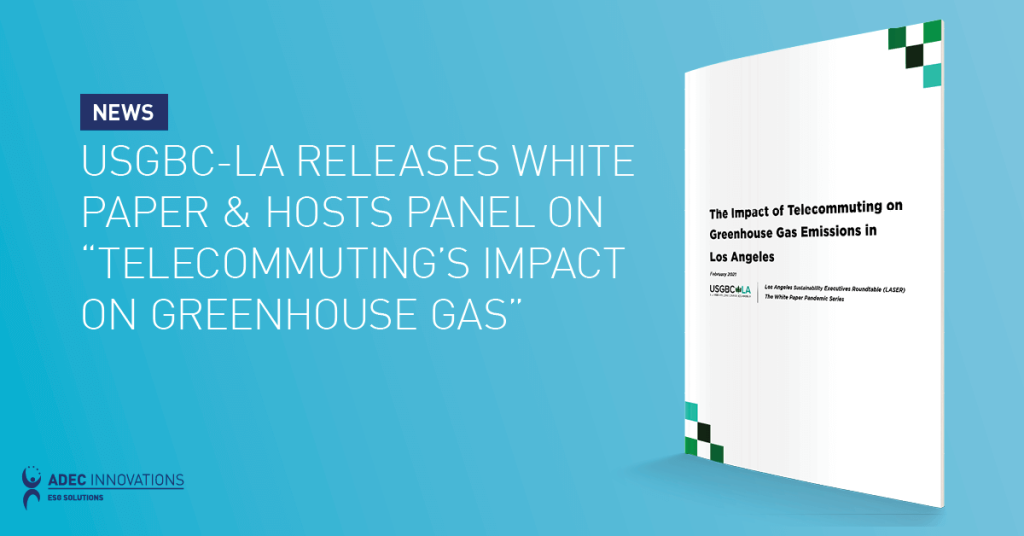
Los Angeles, CA (February 24, 2021) – A year into the COVID-19 pandemic, a significant portion of Angelenos are still telecommuting (aka “working from home”) to prevent the spread of COVID-19. Across the U.S., the number of days worked from home in 2020 more than doubled compared to 2019. Even after the pandemic subsides, experts predict telecommuting rates will remain far higher than pre-pandemic levels, begging the question, how will this shift in workforce location impact the environment?
At 4:00pm PT tomorrow (Feb. 25) the Los Angeles Chapter of the U.S. Green Building Council (USGBC-LA) will host a panel presenting the findings in a white paper, “Telecommuting’s Impact on Greenhouse Gas.” This will be the first paper in USGBC-LA’s White Paper Pandemic Series which will present three whitepapers from now through April, produced in collaboration with the organization’s LA Sustainability Executives Roundtable (LASER) committee, comprised of the region’s top corporate sustainability executives and leaders. Registration for the panel is open and USGBC-LA looks to provide regional environmental leadership around these issues of telecommuting, plastic waste, and carbon offsets as we collectively work to emerge from the pandemic.
This first panel discussion will be framed and moderated by Hilary Norton, Chairwoman and Commissioner, CA Transportation Commission (CTC) with panelists from the LA County Metropolitan Authority, Streetlight Data, and the Electric Power Research Institute (EPRI).
Though it’s often assumed telecommuting reduces greenhouse gas emissions (GHGs), after diving into the scientific literature, the findings aren’t so clear. Telecommuting has a complex impact on both the transportation and building sectors, which combined, are responsible for the vast majority of GHGs in LA County. With this in mind, the white paper explores:
Top Findings & Recommendations:
“This unprecedented collective experience of the pandemic has given us a unique opportunity to evaluate telecommuting as a potential long-term solution to reducing the impact of vehicle related greenhouse gas emissions,” states Ben Stapleton, USGBC-LA Executive Director.
Unfortunately, there are no simple answers to complex questions, but it is clear that going forward we need to leverage this moment to be more strategic about how we use office space and transit incentives to include telecommuting.
Download the white paper now to find out what’s in store for telecommuting in 2021.
Authors: Carli Schoenleber, Alexander Sarno, Derek Farias (graphic design support). Acknowledgements: Ben Stapleton, USGBC-LA Executive Director; Becky Feldman Edwards, LA Sustainability Executives Roundtable (LASER) Program Manager; LASER Leadership Committee; and Special Thanks to: Southern California Gas Company, Los Angeles Department of Water and Power, StreetLight Data, FASTLinkDTLA, building utility data sources, ADEC Innovations, Avital Shavit (LA Metro), Fuijae Lee (LA Metro), Megan Ross (City of LA), Jessica Jinn (City of LA), Joseph Sherlock (Duke University), Robyn Eason (City of West Hollywood), Ali Karim Lee (USGBC-LA), and Erin Lopez (USGBC-LA).
###
About U.S. Green Building Council-Los Angeles
Founded in 2002, USGBC-LA is a 501(c)3 nonprofit organization committed to creating a prosperous and sustainable future within one generation. Our mission is to accelerate all aspects of sustainability in the built environment by delivering access to knowledge, resources, recognition and networking. Learn, Share and Lead Green. (www.usgbc-la.org)